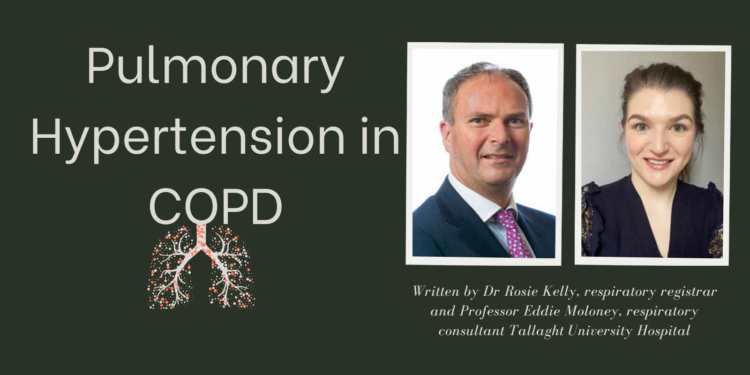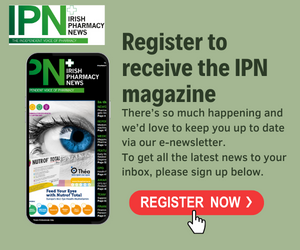Disease course can vary from exertional breathlessness to progressive severe exacerbations requiring hospitalisation. COPD is diagnosed using spirometry with a measurement of forced expired air in one second (FEV1) over forced vital capacity (FVC), the total volume of air expelled in a forced effort. A persistent obstruction in airflow will result in FEV1/FVC ratio of < 70 percent with. FEV1 also used to measure the severity of disease. Pulmonary function testing in a pulmonary laboratory allows for measurement of lung volumes (air trapping and hyperinflation pattern usually seen in COPD) and diffusion capacity for carbon monoxide (DLco) between lung alveoli and pulmonary capillaries. DLco is usually reduced in COPD as a complication of alveolar destruction due to emphysema and maladaptive pulmonary vascular changes which result in pulmonary hypertension.
Written by Dr Rosie Kelly, respiratory registrar and Professor Eddie Moloney, respiratory consultant Tallaght University Hospital

Chronic obstructive pulmonary disease (COPD) is a common, preventable, treatable disease that is characterised by persistent respiratory symptoms and airflow obstruction, usually caused by smoking. Approximately 10 percent of individuals aged 40 years or over have COPD, with estimates of over 500,000 people in Ireland having COPD, most undiagnosed and half of whom have moderate to severe disease, and prevalence increases with age.

Pulmonary hypertension (PH) is a significant complication of COPD, seen commonly in moderate (FEV1 < 80 percent) to severe (FEV1 < 50 percent) disease, and the presence of PH has a significant impact on survival outcomes in COPD. Patients with PH are classified into 5 groups based on aetiology and classification, with group 3 pulmonary hypertension due to chronic lung disease and hypoxaemia, including COPD. Hypoxaemia from COPD results in pulmonary vascular endothelial cell injury promoting pulmonary vasoconstriction to try and maintain ventilation and perfusion balance, cellular proliferation and thrombosis. Given that the majority of COPD patients at risk of PH (moderatesevere disease) will experience breathlessness, a principal symptom of both COPD and PH, it is important to be vigilant in clinical examination of COPD patients for signs attributable to PH. Such findings include a loud second heart sound (P2), signs of right ventricular failure including a raised jugular venous pressure (JVP), an auscultatory third or fourth heart sound, a systolic murmur of tricuspid regurgitation, hepatomegaly, and peripheral oedema. If there is clinical suspicion, a number of non-invasive methods may give further clues. A six minute walk test will often show a rapid decline in oxygen saturations. A CXR may show right ventricular enlargement. An ECG may show signs of right ventricular hypertrophy (right axis deviation, dominant R wave in V1, a peaked P wave in leads II/III/ AVF), or right ventricular strain (ST depression and – T wave inversion in leads V1-V3).
Transthoracic echocardiography (TTE) remains the investigation of choice due to its wide availability. While there is an agreed upon consensus for the definition of PH on pulmonary artery catheterisation (mean pulmonary artery pressure > 20 mmHg), definitions for PH on TTE are less well defined. TTE evaluates the probability of PH using the tricuspid regurgitant jet velocity (TRV). TRV along with right atrial pressure (RAP) can be used to estimate the pulmonary artery systolic pressure (ePASP). PH is suggested echocardiographically when the ePASP exceeds 35 mmHg, and/or when the right ventricular size, wall thickness, and function are abnormal.
However, due to variability in RAP, ePASP may poorly correlate with values obtained by right heart catheterization (RHC).Thus, we support guidelines issued by the European Society of Cardiology (ESC) and the European Respiratory Society (ERS) that propose use of the peak TRV together with echocardiographic findings of PH rather than ePASP to report the echocardiographic probability of PH. Regardless of whether the TRV or ePASP is used, these values should always be interpreted together with clinical suspicion and signs of RV dysfunction. When pulmonary dysfunction is severe enough to explain the degree of PH on echocardiography (eg, severe pulmonary dysfunction and mild PH), RHC is not indicated. RHC is usually reserved for those in whom the severity of PH on echocardiography is not explained by the severity of their underlying CLD (eg, moderate to severe PH with mild lung disease) or for those in whom an alternate aetiology is suspected. If PH is present in the setting of a relatively normal or mildly impaired FEV1, but DLco disproportionately low, a CT Thorax should be considered to check for co-existing interstitial lung disease with COPD, or pulmonary embolic disease.
Should a diagnosis of group 3 PH be established, it is essential that the underlying disease process is managed as well as possible to prevent further progression. This includes smoking cessation and pharmacological therapy to reduce symptoms and reduce frequency and severity of exacerbations. This will aim to optimise lung function and limit hypoxaemia. For specific therapies targeting PH, a recent systematic review showed minimal benefit in pharmacological therapies for COPD-PH. Vasodilator treatment resulted in reduction of measured PAH however this failed to translate into symptomatic improvement or survival benefit for patients with COPD. The only treatment option that showed both haemodynamic and clinical benefits was long term oxygen therapy (LTOT). Guidelines for commencing LTOT in patients with COPD recommend its use in those who show evidence of moderate hypoxaemia (Pa02 <8 mmHg) with pulmonary hypertension and/or polycythaemia (haematocrit >55 percent) or severe hypoxaemia (Pa02 <7.3mmHg). LTOT, when used correctly at a minimum of 15 hours per day, could slow progression of PH and reduce mortality. Unfortunately, correction of hypoxaemia at this point is unlikely to reverse vascular remodelling.
COPD-PH is a significant complication with direct impact on outcomes in a disease that already has significant morbidity and mortality. Recognition of this complication requires vigilance in clinical examination and an awareness of clues on readily available investigations such as six minute walk test, ECG, CXR and pulmonary function testing. Echocardiography can be used to diagnose PH but results should be interpreted in combination with the clinical picture, should results be incongruous referral for expert opinion for consideration of RHC should be sought. Management of COPD-PH remains focused on correction of hypoxaemia with targeted treatments to lower PAH showing minimal clinical benefits at this stage.
References available on request
View the November Magazine HERE












